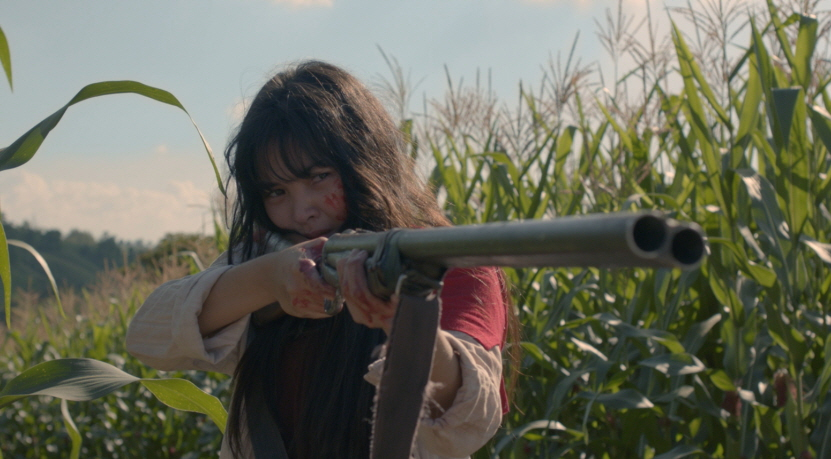During the 2019 Metro Manila Film Festival, the 2016 film Oro was once again brought up on social media because of the film entry Culion, directed by the same man who wrote and directed the former. Activists who condemned Oro four years ago came out of the woodwork to call for a boycott of Culion, the death of the unnamed dog still fresh in social memory.
What happened in the film and the response of viewers said a lot about how Filipinos valued animal life, but Oro is only one of the Filipino films that have put animal issued at the forefront in recent years.
Oro (2016)
Oro is inspired by the events of March 23, 2014, when four miners in Barangay Gata in Caramoan, Camarines Sur were killed by members of an environmental group. The treatment of human and animal life is put side by side throughout the film with the use of animal imagery and metaphors.
The most controversial scene, however, showed actors placing a dog in a sack, and then, in muted colors, eviscerating the dog’s lifeless body as it hung upside down. In the film, the four Gata miners were said to have been shot “parang hayop” (like animals). The dog’s death foreshadowed the murders of the four.

Issues: Killing and eating dogs/animals
It came to light that that dog was actually killed during the film’s production. The Philippine Animal Welfare Society (PAWS) filed a complaint against director Alvin Yapan and producer Mark Shandii Bacolod for violating Republic Act 8485 (the Animal Welfare Act), only for a prosecutor to dismiss the complaint a few months later, according to a 2017 article from ABS-CBN News. PETA called for the awards film won to be revoked, according to a 2017 article by Nirali Shah for PETA Asia.
While the filmmakers’ use of animal themes to highlight the degradation of social order is commendable, profiting off the filmed slaughter of a dog cast them in the same light as the barbaric murderers they portrayed. The scandal fueled discourse of the value Filipinos place on life, and whether the life of a dog is equal to that of a human or even that of a pig.
Birdshot (2016)
Maya, the young daughter of a caretaker, is taught how to hunt by her father. While out with her dog, Bala, she shoots and kills a Philippine eagle in a sanctuary. This leads the police to look into the eagle’s disappearance at the same time as an investigation into the disappearance of a group of farmers.

Issues: Hunting, endangered species, animal cruelty
While Maya and her father hunt duck at the beginning of the film, it is the death of the haribon that is critical to the plot. The eagle is cooked, fed to the family (including Bala), then buried – save for a claw Maya turns into a necklace. The Philippine eagle is critically endangered and is most vulnerable to deforestation and shooting. One haribon is shot to death every year, according to the Philippine Eagle Foundation.
Birdshot also touches on the link between animal cruelty and human violence – a link that even the Humane Society of the United States has acknowledged, as stated on their website. At the beginning of the film, jaded policeman Mendoza isn’t bothered by the sight of a run-over dog, while newly recruited policeman Domingo stares at it in shock. Later, once Domingo has understood the crooked ways of the police force, it is he who has no problem torturing others and killing Bala in cold blood.
Bwakaw (2012)
The late Eddie Garcia plays Rene, a gay man in his 70s whose best friend is his dog, Bwakaw. Convinced of his nearing death, he packs all his belongings and finalizes his will. Bwakaw’s unexpected death from cancer marks a positive change in Rene’s outlook on life.

Issues: Pets in public transport, the treatment of aspins, senior loneliness
When Rene travels to work with Bwakaw in a trike, the trike driver berates him for not paying extra for his dog. The LTFRB announced that pets would finally be allowed to ride in public utility vehicles in 2019, but the act is still often frowned upon.
Bwakaw’s origin story is also quite similar to that of any Brownie or Whitey aspin on the streets. Rene didn’t consider her his dog at first; he only ever fed her his leftovers. Accountability for stray dogs is often lost until one feels solely responsible for them. At one point, Rene called Bwakaw a bad guard dog, which is exactly what many homeowners acquire aspins for.
The most heartbreaking part of the film begins when Bwakaw suffers a heat stroke and is diagnosed with cancer, and Rene is advised to pray. He then asks, “Sa palagay mo ba magmimilagro ang Diyos sa isang aso lang? (Do you really think God would perform a miracle on a dog?)” Like in Oro, the value of animal life is put into question, and yet it is clear that Bwakaw was more than just a dog to Rene. Rene was a senior battling loneliness, a condition pets have been proven to alleviate, according to a 2013 article by Ian H. Stanley and colleagues published in the journal Aging and Mental Health.
Unforgettable (2019)
Sarah Geronimo plays Jasmine, a young girl attached to her grandmother, Lola Olive. When Lola Olive falls ill and is treated in Baguio, Jasmine vows to find her way to her from Manila alone. She finds a friend in Happy, a stray dog similar to the dog Lola Olive once had.

Issues: Pet in public transport, treatment of aspins and euthanasia in pounds, emotional support animals
Though the love that Lola Olive and Jasmine feel for Happy is palpable through the screen, the parts of the film that keep viewers on the edge of their seats involve Happy in danger. On the way to Baguio, Jasmine and Happy are kicked out of their bus because pets aren’t allowed in public transport. The climax of the film also shows Jasmine searching for Happy, who she fears was euthanized by the local pound. The reality is that many animal shelters and pounds resort to euthanasia because it is viewed as quick, painless, and necessary in a society where there is an overpopulation of animals, according to PETA’s website.
Perhaps the most striking relationship in Unforgettable us that between Jasmine and Happy. As reported in a 2019 article from ABS-CBN News, in Unforgettable, Happy helps Jasmine through the symptoms of her autism, providing her with the unwavering companionship of an emotional support animal.
The use of animals
During the furor over Oro in 2016, PAWS said, “Animals should never be harmed, killed or reduced as mere props to be discarded after the shooting of a movie.” They must be respected as “sentient creatures,” and if possible, should be substituted in film with CGI or inanimate objects instead, according to a 2017 article from ABS-CBN News.
In Birdshot, Bala is credited as Argo. In Bwakaw, the titular role was played by a dog named Princess. In Unforgettable, Happy is listed in the credits as Milo. The lead animals in the aforementioned films were given enough respect to at least be credited for their work, but it is the no-names like those in Oro that the public should also aim to protect.
This appeared in Animal Scene magazine’s March 2020 issue.
You might want to read:
– Woman records hilarious video of cat watching rats fight
– Robot dolphins created to replace real animals in captivity
– What makes dogs so special? Science says love




